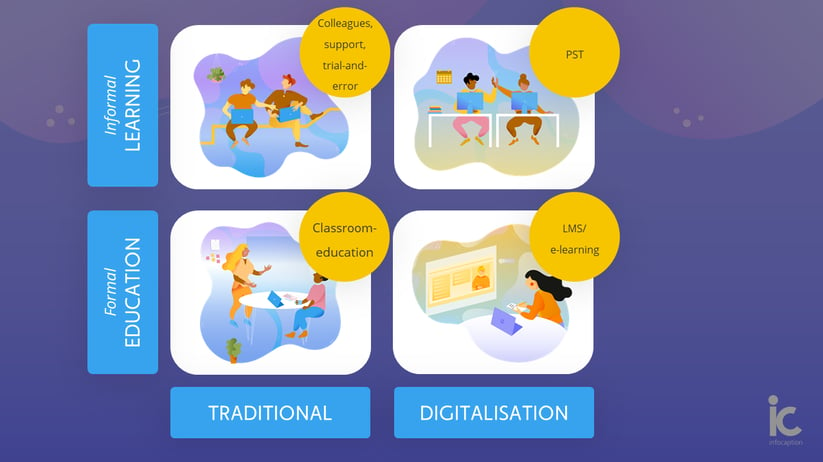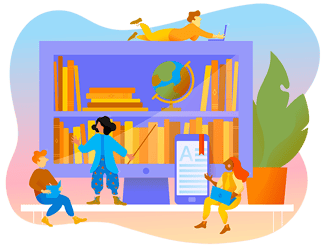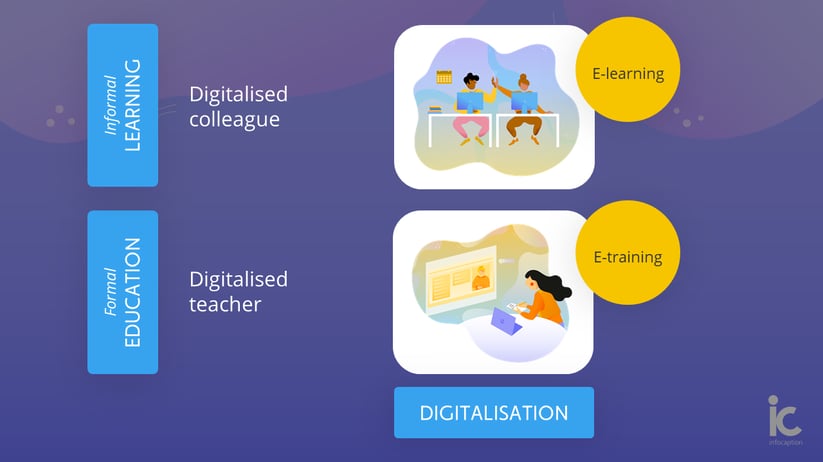With high staff turnover, rapid changes and scarce resources, digitalisation of education is becoming increasingly important. However, making education digital is neither the only nor the most important measure in a business that wants to maximize the impact of digital learning.
Digital vs. non-digital learning
The benefits of e-learning and digital education are well known: Making an education digital means that more people can access it and that you can take part in it whenever you want, where you want and how many times you want. It becomes both site and person independent.
But digitalisation creates opportunities for more benefit than that - there is a difference between formal education and learning in an informal way in daily work.
In more or less all workplaces, there is both formal education and informal learning in some form.
- In formal education, there is a teacher or course coordinator who decides what is important and what is to be taught, both in terms of quantity and content.
- In informal learning, it is the person who needs to learn who decides what is relevant and sekes out the knowledge on their own, when needed.
In a workplace without digital learning at all, formal education usually takes place under the guidance of a classroom teacher. Informal learning takes place through trial-and-error, Post-it notes and by asking colleagues or the support departement for help when you wonder how a certain system works or how a certain task should be performed.
In a fully digitalized workplace, the formal education takes place through e-learning, usually in a learning platform (LMS - Learning Management System). Informal learning is instead managed through Performance Support Tools (PST) - "performance support" or workflow learning.
 Learning matrix: a simplified schedule about the forms of formal education and informal learning in a traditional and digitzed context.
Learning matrix: a simplified schedule about the forms of formal education and informal learning in a traditional and digitzed context.
Few organisations, if any, are completely digital (or for that matter completely non-digital). It is probably not desirable either way - digital education and digital learning are not always preferable to physical ones; there is value in the personal meeting and the opportunity for interaction that it provides.
However, there is a natural efficiency gain to be made, in saved resources, when physical education and knowledge support are made digital. But the main purpose of the digitalisation is not necessarily to completely replace physical with digital - but rather to shift focus in the learning strategy and thereby increase the effect you get out of educational efforts.
Organise the knowledge that exists in the organisation
Many organisations may think that digital learning is about moving the classroom education to an LMS, and converting paper manuals into PDF manuals. If you settle with that, however, you miss the fourth part of what is illustrated in the matrix above - to digitize the informal daily learning.
Theoretically, the best thing from an employee's perspective would be for a personal coach or expert to be around all the time. Such a coach could answer questions when needed and explain things at your command, as a helping hand. From the organisation's perspective, it would of course be an expensive and resource demanding solution - but with the help of Performance Support, one can approach such support!
Performance Support is about inventorying, organising and not least making available the informal knowledge that exists among all employees in an organisation. It can be compared to a library with many small knowledge articles: no one goes to the library to read through every single book from beginning to end, but through the clear structure with books in categorised and organised shelves, you can easily find exactly what you are looking for.
Dynamic digital learning is based on the employees' need to complete tasks. The most important thing is not the amount of education, but rather the timing of the learning!
Supplement education with Performance Support
Both formal education and informal learning are needed but are suited for different situations. Most organisations have a good grasp of formal education: "What do you need to know to work here". For some functions, certifications may be required and it is therefore ensured that employees must be approved for special courses before they can start working.
However, you should not fill the courses with all conceivable "good-to-know" knowledge - there is a difference between what is good to know and what you need to know. There is an intristic value in keeping the educational content as concise as possible because people have a limited capacity in how much you can learn at once. Most things can actually be taught in informal ways in everyday work.
Most often, there are not very much resources spent on planning for informal learning, even if it is an obvious part of many people's everyday lives to ask for help or search for the information they need. ONe could say that Performance Support (workflow learning) in its most simple form could be a post-it note on the computer, a manual on your desk or a quick question to a colleague; however, the term refers above all to the digital tools that help to better structure this informal learning.
In what situation does the employee learn best?
With Performance Support tools, the post-it note or the question to the colleague is digitized - without sacrificing accessibility! The core of the concept is that the support must be available where it is "best learned", that is: in the situation or situations when the employee has the greatest need to learn a certain element and thus the greatest chance of absorbing the knowledge.
It is a matter of motivation. As a rule, you are more motivated to learn when you are faced with an actual challenge in your working day that needs to be met, than when you leave work to participate in a compulsory education.
On the first day as a new employee, you may not listen with full capacity to a lecture on holiday administration, but once it is time to register your holiday, the need for the knowledge is all the greater - and thus the motivation!

The balance between imparting knowledge through formal education or informal learning should be an impact assessment. "What could happen if you try to do your job without knowing it completely?"
If you learn wrong about how medicines should be dispensed or how to put out a fire, it can have serious consequences, while if you fail to change the standard printer or register a holiday the wrong way, you just have to try again. The latter is suitable for trial-and-error and self-studies, but the former is not!
Which format is best suited for which situation?
E-learning is used to digitize education/formal learning and Performance Support tools are used to digitize informal learning. So what are the practical differences between Performance Support and e-learning in LMS, and when should each format be used?
How are they produced and what should they contain?
- E-learning is often developed with the help of greater resources, experienced educators and producers with the goal of educating the participants about somthing they need to know. The content should primarily be of an informative nature.
- Performance Support is more often developed with small means to meet a concrete and more direct need for knowledge: "I supposed to do this - how do I do it?". The content is mainly of an instructive nature.
What is their scope?
- E-learning courses are often quite long, sometimes several hours, and require a planned break from work.
- Performance Support is usually shorter, sometimes just a few minutes or seconds. You learn while working rather than taking a break from work.
How are they made available?
- E-learning is usually available after login in a learning platform (LMS) where you can see your progress and a manager or administrator can follow up results.
- The focus for Performance Support is "just-in-time" - to make knowledge available within a few (preferably no) clicks, just when help is needed, so that you quickly can get on with your work tasks.
In summary:
LMS with e-learning means formal education in a digital format, with the goal of giving the recipient new knowledge and skills. The focus is on the bigger picture. A digital teacher!
Performance Support tools structure informal learning in a digital format, with the goal of helping the recipient to complete work tasks. The focus is on the details. A digital colleague!
 If what is traditionally called e-learning is about digitizing a knowledgable teacher or lecturer, Performance Support is more about digitizing your knowledgable colleagues.
If what is traditionally called e-learning is about digitizing a knowledgable teacher or lecturer, Performance Support is more about digitizing your knowledgable colleagues.
Why e-learning is really e-training
When digitizing education, the term e-learning is usually used. But even if the format is digital, the content is often more or less the same - that is, formal educating (training) rather than practical learning at the moment. With e-learning, you educate and prepare yourself to be able to do a better job, you train. Most of the actual learning instead takes place while you are at work, during the working day: by performing your tasks, perhaps applying something you was taught through e-learning and by asking your colleagues for help.
Therefore, what is usually called e-learning should perhaps rather be called e-training! Real
e-learning is rather what can be achieved with the help of digital Performance Support tools.
Formal education is not something we should stop working with, but before we design these, we should think about what the purpose of the education really is. Most times, the purpose is for the employees to perform better; to do their job better. Then start from there! Start by creating materials that support the execution first! Make the material available as Performance Support in the workflow rather than in a course portal and in short knowledge articles rather than long ones. Then you can go back and create a compulsory and formal - but concise - education, which contains what you need to know before facing a work situation. The shorter education becomes easier to take in while support for continuous learning is close at hand, every day.
What we are advocating is a redistribution of focus and resources. In general, a disproportionate amount of energy is spent on formal education in relation to what is spent on informal and continuous learning in everyday work. The organisations that want to get more effect out of the resources they invest in digitization, education, competence provision and learning should shift focus - a little less training and a little more learning, please.

